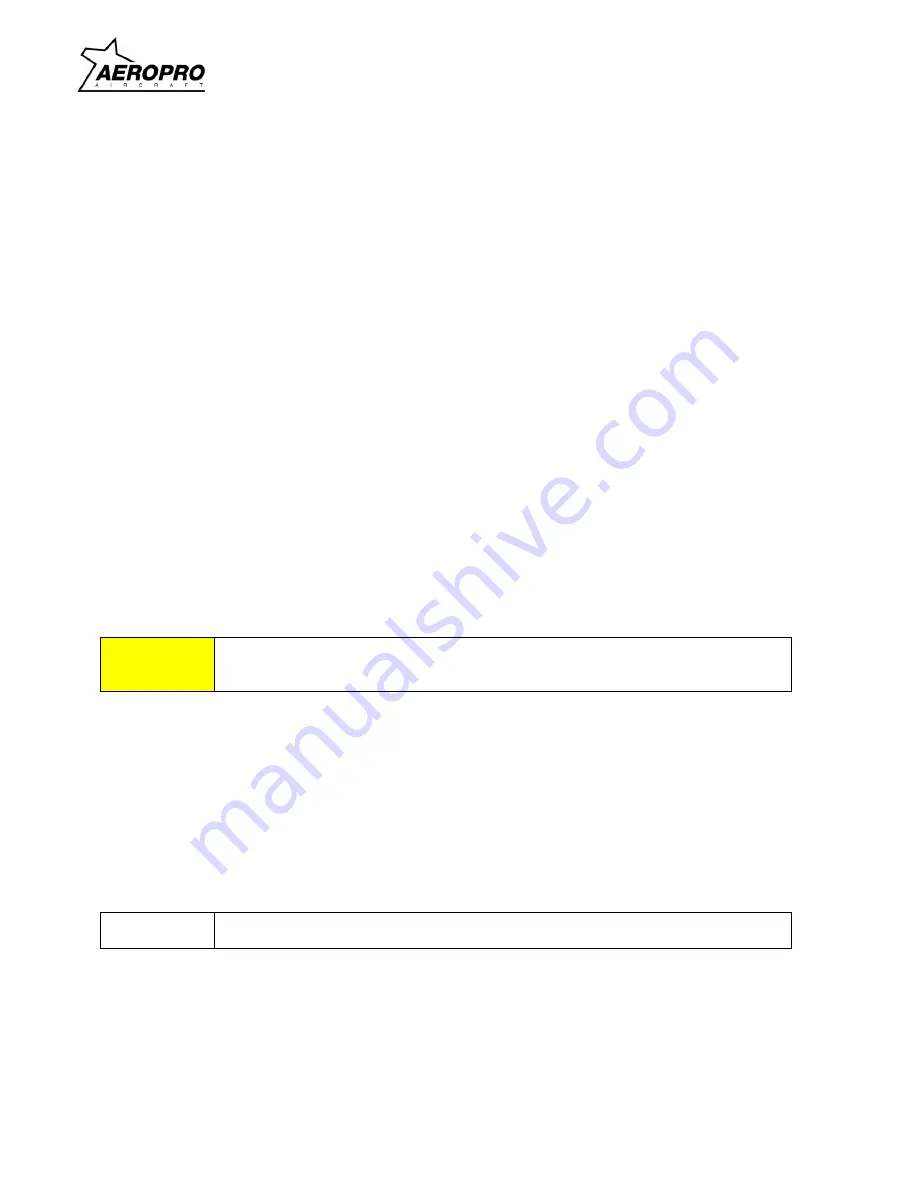
Maintenance Manual
AEROPRO CZ
3-2
Maintenance Manual
March 21, 2020
3.4 Cleaning
Refer to Section 2.
3.5 Waxing
Waxing will remove minor scratches in clear plastic and help protect the surface from further
abrasion. Use a good grade of commercial wax applied in a thin, even coat. Bring wax to a high polish by
rubbing lightly with a clean, dry flannel cloth.
3.6 Repairs of Windshield
Damaged window panels and windshield may be removed and replaced if damage is extensive.
However, certain repairs as prescribed in the following paragraphs can be made successfully on the
acrylic front windshield without removing the damaged screen from aircraft. Three types of temporary
repairs for cracked plastic are possible. No repairs of any kind are recommended on highly-stressed or
compound curves where repair would be likely to affect pilot’s field of vision. Curved areas are more
difficult to repair than flat areas and any repaired area is both structurally and optically inferior to the
original surface.
3.7 Scratches
Scratches on clear acrylic (but not polycarbonate) surfaces can be removed by hand-sanding
operations followed by buffing and polishing, if steps below are followed carefully.
a.
Before attempting any scratch removal it is necessary to confirm the process and materials and
tools being used with the Aeropro aircraft factory, the distributor, a qualified aviation technician, or
a distributor of the acrylic material.
b.
Wrap a piece of extremely fine sandpaper or abrasive cloth around a rubber pad or block of wood.
Rub surface around scratch with a circular motion, keeping abrasive constantly wet with clean
water to prevent scratching surface further. Use minimum pressure and cover an area large
enough to prevent formation optical distortions.
c.
Continue sanding operation, using progressively finer grade abrasives until scratches disappear.
Do not skip one grade of abrasive!
d.
When scratches have been removed, wash area thoroughly with clean water to remove all gritty
particles. The entire sanded area will be clouded with minute scratches which must be removed
to restore transparency.
e.
Apply first tallow or buffing compound to a motor-driven buffing wheel. Hold wheel against plastic
surface, moving it constantly over damaged area until cloudy appearance disappears. A 2000-
feet-per-minute surface speed is recommended to prevent overheating and distortion. (Example:
750 rpm polishing machine with a 10 inch buffing bonnet)
f.
When buffing is finished, wash area thoroughly and dry with a soft flannel cloth. Allow surface to
cool and inspect area to determine if full transparency has been restored . Apply a thin coat of
hard wax and polish surface lightly with a clean flannel cloth.
Caution
Do not use a coarse grade of abrasive. No 400 is of maximum coarseness.
Note
Polishing can be accomplished by hand but will require a considerably longer period
of time to attain the same result as produced by a buffing wheel.
Summary of Contents for CZ A220
Page 19: ...Maintenance Manual AEROPRO CZ 2 6 Maintenance Manual March 21 2020 Figure 2 2 ...
Page 32: ...Maintenance Manual AEROPRO CZ 3 8 Maintenance Manual March 21 2020 Figure 3 3 ...
Page 35: ...Maintenance Manual AEROPRO CZ 4 2 Maintenance Manual March 21 2020 Figure 4 1 ...
Page 57: ...Maintenance Manual AEROPRO CZ 6 4 Maintenance Manual March 21 2020 Figure 6 2 ...
Page 60: ...Maintenance Manual AEROPRO CZ 6 7 Maintenance Manual March 21 2020 ...
Page 94: ...Maintenance Manual AEROPRO CZ 10 23 Maintenance Manual March 21 2020 ...
Page 105: ...Maintenance Manual AEROPRO CZ 10a 11 Maintenance Manual March 21 2020 ...
Page 106: ...Maintenance Manual AEROPRO CZ 10a 12 Maintenance Manual March 21 2020 ...
Page 107: ...Maintenance Manual AEROPRO CZ 10a 13 Maintenance Manual March 21 2020 ...
Page 150: ...Maintenance Manual AEROPRO CZ 20 3 Maintenance Manual March 21 2020 Figure 2 2 ...
















































